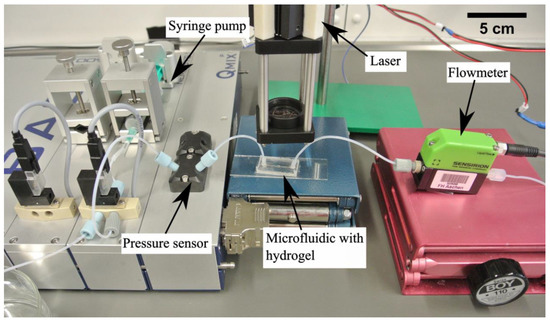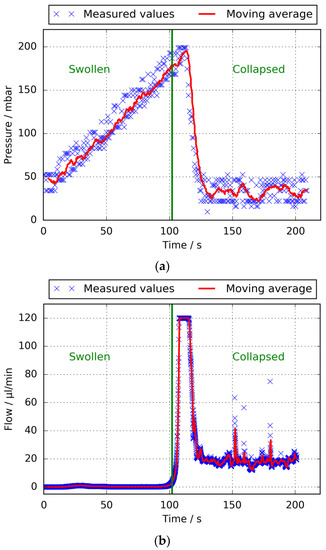Abstract
Temperature-responsive Poly-N-isopropylacrylamide (PNIPAAm) hydrogels were modified with graphene oxide (GO) nanoparticles to increase the light absorption significantly and these gels can be heated and stimulated optothermically. These light-responsive hydrogels are promising candidates as actuator material for microfluidic applications. For demonstration, the hydrogels were tested as light-driven valves for the active flow control within microfluidic channels by monitoring the pressure and flow for different operation states.
1. Introduction
The importance of microfluidic technologies has significantly increased during the last decade due to their important role for the development of lab-on-chip (LoC) devices [1]. Because of the large number of possible functionalities such as detection, mixing and separation of analytes, drug release and flow control, etc., LoC systems have to comprise a variety of different elements including electronic, mechanical and fluidic units [2,3]. Actuators such as valves are essential for the flow control within those microfluidic systems. Often, conventional microvalves are miniaturized versions of large-scale devices leading to expensive components as well as complex assemblies. To improve this, new concepts for simpler and inexpensive actuator technologies are required. Stimulus-responsive hydrogels are known as possible materials for micro-actuators in LoC systems. They undergo significant volume changes in response to the variation of certain environmental parameters [4,5]. Among these stimuli, the control of the material by light exposure is a very attractive option since there is no need of a physical contact, which is advantageous for sterile working conditions. In addition, the location, size and intensity of stimulation can be controlled easily by a light beam.
2. Experimental and Results
To demonstrate the application as valve, temperature-sensitive hydrogels based on the monomer N-isopropylacrylamide (NIPAAm) were polymerized within the channels of polydimethylsiloxane (PDMS) microfluidics. To achieve a light-controllable material, the hydrogels were modified with graphene oxide (GO) nanoparticles to enhance the light absorption in the visible range. In contrast to pure hydrogels, the hydrogels with GO can be stimulated spatially resolved by illumination depending on the position and geometry of the light beam [6,7]. This light-responsive hydrogels can be applied to realize light-driven valves. The microfluidics were fabricated by curing of PDMS within a mold with the desired channel geometry and afterwards, the PDMS structure was plasma-bonded to a glass substrate. A proper bonding between the hydrogel and the microfluidic structure is required to withstand a certain pressure level and to provide a proper sealing. Therefore, the microfluidics were pre-treated with HellmanexIII solution (Hellma Analytics) for surface activation and a 0.5 wt % solution of 3-(dimethylchlorosilyl)propyl methacrylate (Sigma Aldrich) as adhesion promoter. After that, the hydrogels were synthesized within the channels by an in situ photopolmyerization process utilizing an ultraviolet (UV) LED. Figure 1 depicts the setup for the valve testing measurements. It contains a syringe pump to generate the required flow (neMESYS 290N, CETONI GmbH), a pressure sensor before (Qmix P, CETONI GmbH), and a flow meter after the hydrogel structure (SLI-0430, Sensirion AG).

Figure 1.
Setup for the characterization of the valve functionality including a laser for the stimulation of the hydrogels, a syringe pump to generate the required flow and a pressure sensor and a flowmeter to record the relevant parameters within the system.
The pressure within the system and the flow through the channel was detected for different states of the hydrogel (Figure 2). The syringe pump used for the experiments was set to a constant flow rate of 20 µL/min pumping water as test liquid. For the swollen state, the hydrogel has a several orders of magnitude higher volume compared to the unswollen sate and blocks the channel leading to an increase in pressure upon continuous pumping but no significant flow occurred. When the switching temperature of 32 °C (lower critical solution temperature, LCST) is exceeded, the polymer collapses. This leads to a contraction of the polymer network and a decrease in volume and thus, the channel is no longer blocked and the pressure drops significantly. Because of the overpressure in advance of the opening procedure, the flow rises and overshoots to a value of 120 µL/min (maximum flow rate detectable by the flow sensor) directly after the collapsing process but then reduces to the set flow rate of 20 µL/min generated by the syringe pump. This demonstrates a proof-of-concept for the application as valve within microfluidic systems of e.g., LoC devices.

Figure 2.
Proof-of-concept for the application as microvalve: Pressure (a) and flow (b) within the system for the swollen and collapsed state of the hydrogel, the green line indicates the power-on event of the stimulus. For the swollen hydrogel, the channel is blocked so that no significant flow occurs and the pressure rises. When the hydrogel collapses, the channel is opened leading to a decrease in pressure and the liquid flows through the microfluidic.
3. Conclusions
Hydrogels based on the temperature-sensitive monomer NIPAAm were modified with GO nanoparticles so that the volume of the material can be switched by illumination. These hydrogels were fabricated within channels of PDMS microfluidics by in situ photopolymerization and the pressure as well as the flow within the system was monitored for different swelling ratios of the hydrogel. The flow is blocked for the swollen state and after stimulation, the channel is opened. The obtained results demonstrate the potential of the hydrogel actuators to be applied as remote-controlled valves within microfluidic systems.
Acknowledgments
This work was supported by the German Federal Ministry of Education and Research (Bundesamt für Bildung und Forschung, BMBF) within the research frame of “NanoMatFutur” (13N12585).
Conflicts of Interest
The authos declare no conflict of interest. The founding sponsors had no role in the design of the study; in the collection, analysis or interpretation of data; in the writing of the manuscript, and in the decision to publish the results.
References
- Sackmann, E.K.; Fulton, A.L.; Beebe, D.J. The present and future role of microfluidics in biomedical research. Nature 2014, 507, 181–189. [Google Scholar] [PubMed]
- Luo, Q.; Mutlu, S.; Gianchandani, Y.B.; Svec, F.; Fréchet, J.M. Monolithic valves for microfluidic chips based on thermoresponsive polymer gels. Electrophoresis 2003, 24, 3694–3702. [Google Scholar] [CrossRef] [PubMed]
- Lim, Y.C.; Kouzani, A.Z.; Duan, W. Lab-on-a-chip: A component view. Microsyst. Technol. 2010, 16, 1995–2015. [Google Scholar] [CrossRef]
- Qiu, Y.; Park, K. Environment-sensitive hydrogels for drug delivery. Adv. Drug Deliv. Rev. 2001, 53, 321–339. [Google Scholar] [CrossRef]
- Kuckling, D. Responsive hydrogel layers from synthesis to applications. Colloid Polym. Sci. 2009, 287, 881–891. [Google Scholar] [CrossRef]
- Breuer, L.; Raue, M.; Kirschbaum, M.; Mang, T.; Schöning, M.J.; Thoelen, R.; Wagner, T. Light-controllable polymeric material based on temperature-sensitive hydrogels with incorporated graphene oxide. Phys. Status Solidi A 2015, 212, 1368–1374. [Google Scholar] [CrossRef]
- Breuer, L.; Raue, M.; Strobel, M.; Mang, T.; Schöning, M.J.; Thoelen, R.; Wagner, T. Hydrogels with incorporated graphene oxide as light-addressable actuator materials for cell culture environments in lab-on-chip systems. Phys. Status Solidi A 2016, 213, 1520–1525. [Google Scholar] [CrossRef]
Publisher’s Note: MDPI stays neutral with regard to jurisdictional claims in published maps and institutional affiliations. |
© 2017 by the authors. Licensee MDPI, Basel, Switzerland. This article is an open access article distributed under the terms and conditions of the Creative Commons Attribution (CC BY) license (https://creativecommons.org/licenses/by/4.0/).